
|
Sale 108
NY International Coin Auction January 8-10, 2019
| Lot |
Photo |
Description |
Realized |
Lot 246 |
 |
Augustus. Silver Denarius (4.08 g, 2h), 27 BC - AD 14. Mint of Rome, struck by P. Petronius Turpilianus, 19 B.C. AVGVSTVS CAESAR, bare head facing right. Rev. TVRPILIANVS III VIR, six-rayed star within a crescent (RIC 300; BMC 32). A superb example, well-centred on a flan of excellent metal, outstanding portrait, beautiful old cabinet toning, Superb Extremely Fine. Estimate Value $10,000 - UP
Ex Nomisma, Sale 16, 2000, lot 205 Ex Numismatica Ars Classica, Auction 72, 16 May 2013, lot 568.
View details and enlarged photos
| Unsold |
Lot 247 |
 |
Augustus. Silver Denarius (3.85 g, 9h), 27 BC - AD 14. Mint of Rome, 13 B.C. AVGVSTVS CAESAR, bare head facing right. Rev. C ANTISTIVS REGINVS, simpulum and lituus above a tripod and a patera (RIC 410; BMC 120). Purple-grey cabinet toning, good portrait, Extremely Fine. Estimate Value $4,000 - UP
Ex Stack�s Bowers, Sale 174, 12 January 2013, lot 6007 Ex Roma, Auction 6, 29 September 2013, lot 837.
View details and enlarged photos
| Unsold |
Lot 248 |
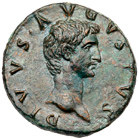 |
Divus Augustus. Æ As (12.49 g), died AD 14. Rome, restitution issue under Nerva, AD 98. DIVVS AVGVSTVS, bare head of Augustus right. Rev. IMP NERVA CAES AVG REST, S C in exergue, winged thunderbolt. RIC 130; Komnick type 10.0; BN 151; BMC 161. Wonderful portrait. Glossy greenish-brown patina. Some smoothing in the fields noted. Very scarce type. About Extremely Fine. Estimate Value $500 - UP
Ex Alberto Campana Collection (NAC 64, 17 Nay 2012), 2408; Gorny & Mosch 118 (14 October 2002), 2000.
View details and enlarged photos
| Realized
$480 |
Lot 249 |
 |
Tiberius. Gold Aureus (7.82 g, 6h), AC 14-37. Mint of Lugudnum. TI CAESAR DIVI AVG F AVGVSTVS, laureate head facing right. Rev. PONTIF MAXIM, Female figure (Livia?) seated right, holding a sceptre and a branch (RIC 29; BMC 46; Calicó 305c). A superb example, fully lustrous and struck on a broad flan, excellent portrait, Superb Extremely Fine. Estimate Value $15,000 - UP
View details and enlarged photos
| Unsold |
Lot 250 |
 |
Tiberius. Gold Aureus (7.72 g), AD 14-37. 'Tribute Penny' type. Lugdunum, AD 18-35. TI CAESAR DIVI AVG F AVGVSTVS, laureate head of Tiberius right. Rev. PONTIF MAXIM, Livia, as Pax, seated right on chair with ornate legs, holding scepter and olive branch. RIC 29; Lyon 149; BMC 46; Calicó 305a. Boldly struck on a nice broad flan, fully lustrous and perfectly centered. Die crack across cheek. NGC grade MS; Strike: 5/5, Surface: 5/5. Estimate Value $10,000 - UP
View details and enlarged photos
| Realized
$12,600 |
Lot 251 |
 |
Tiberius, AD 14-37. Silver Denarius (3.78g). Mint of Lugudnum. TI CAESAR DIVI AVG F AVGVSTVS, laureate head of Tiberius right. Rev. PONTIF MAXIM, Livia (as Pax) seated right, holding olive-branch and long vertical sceptre. Excellent portrait struck in high relief on a nice broad flan. Perfectly centered and lightly toned. Extremely Fine. Estimate Value $1,000 - UP
View details and enlarged photos
| Unsold |
Lot 252 |
 |
Claudius. Gold Aureus (7.78 g, 6h), AD 41-54. Mint of Rome, A.D. 44-5. TI CLAVD CAESAR AVG P M TR P IIII, laureate head facing right. Rev. PACI AVGVSTAE, Pax-Nemesis walking right, holding-out a fold of drapery, and pointing a winged caduceus towards a serpent at her feet (RIC 27; Calicó 366; BMC 26). Traces of residual lustre, excellent portrait, nearly Extremely Fine. Estimate Value $25,000 - UP
Ex Classical Numismatic Group, Triton XVII, 7 January 2014, lot 649.
View details and enlarged photos
| Unsold |
Lot 253 |
 |
Claudius. Æ Quadrans (2.84 g), AD 41-54. Rome, AD 41. Three-legged modius. Reverse: Large S C. RIC 84. Green patina, nice surfaces and bold detail. A superb example. Extremely Fine. Estimate Value $400 - UP
View details and enlarged photos
| Unsold |
Lot 254 |
 |
Nero. Gold Aureus (7.31 g, 7h), AD 54-68. Mint of Rome, A.D. 65-6. NERO CAESAR AVGVSTVS, laureate head facing right. Rev. SALVS, Salus seated left on a throne, holding a patera in her extended right hand (RIC 59; Calicó 443; BMC 87). Broad flan, red toning, Extremely Fine, possibly from the Boscoreale Hoard. Estimate Value $15,000 - UP
Ex Stack�s Bowers, Sale 177, 13 August 2013, lot 11138.
View details and enlarged photos
| Unsold |
Lot 255 |
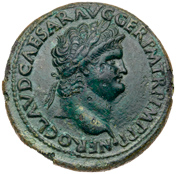 |
Nero. Æ Sestertius (22.31 g), AD 54-68. Lugdunum, ca. AD 65. NERO CLAVD CAESAR AVG GER P M TR P IMP P P, laureate head of Nero right, globe at point of bust. Rev. ANNONA AVGVSTI CERES, S C in exergue, Annona standing right, holding cornucopiae, facing Ceres seated left, holding grain ears and torch; between them, modius set on altar and ship's stern. RIC 430; BN 70; WCN 416; BMC 305. Hard apple-green patina. Some minor chipping around the edges. Old smoothing in the fields. Choice Very Fine. Estimate Value $2,000 - UP
Ex Spink, March 1936; Sir Arthur J. Evans Collection (Ars Classica XVII, 3 October 1934),1271 (acquired in 1911).
View details and enlarged photos
| Unsold |
Lot 256 |
 |
Nero. Silver Hemidrachm (1.78 g), AD 54-68. Caeasarea in Cappadocia, after AD 60. Laureate head of Nero right. Reverse: ARME-NIAC across field, Nike advancing right, holding palm and wreath. Sydenham 81; RPC 3644. The obverse struck slightly off center. Excellent detail with some porosity. Very scarce. Choice Very Fine. Estimate Value $400 - UP
This issue was struck to celebrate Corbulo's victories in Armenia.
View details and enlarged photos
| Unsold |
Lot 257 |
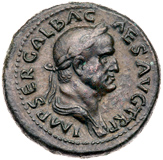 |
Galba. Æ Sestertius (26.56 g), AD 68-69. Rome. IMP SER GALBA C-AES AVG TR P, laureate and draped bust of Galba right. Rev. RO-MA, S C across field, Roma standing facing, head left, holding Victory and spear. RIC 358; BMC p. 321; ACG 96. Glossy dark chocolate brown patina. Marvelous bold portrait. Extremely Fine. Estimate Value $2,500 - UP
Ex Baldwin's inventory, March 1937.
View details and enlarged photos
| Unsold |
Lot 258 |
 |
Vitellius. Silver Denarius (3.49 g), AD 69. Rome. A VITELLIVS GERM IMP AVG TR P, laureate head of Vitellius right. Rev. PONT MAXIM, Vesta, veiled, seated on throne right, holding patera and scepter. RIC 107; BMC 34; RSC 72. Well struck on excellent metal and full complete legends on both sides. Lightly toned with traces of luster remaining. Extremely Fine. Estimate Value $1,500 - UP
Before becoming emperor, the elderly Galba, governor of Hispania Terraconensis, served many years as a capable administrator and military leader, having previously governed in Gaul, Germany, Africa and Spain, where he had earned a reputation for strictness and impartiality. Hearing that he was in disfavor with Nero and that he would soon be executed, he considered joining the revolt of the governor of Gallia Lugdunensis, Gaius Julius Vindex, who had promised him his support in a bid for the throne. He hesitated, however, which was probably fateful as Vindex's revolt was quickly suppressed, the usurper committing suicide. The turmoil in Rome continued, and in June AD 68 the Praetorian Prefect, Nymphidius Sabinus, transferred his allegiance to Galba. Nero, deserted by the Praetorians, was declared a public enemy by the Senate and committed suicide. Galba promptly took the title of Caesar, raised a legion, and along with the governor of Lusitania, Marcus Salvius Otho, quickly marched on Rome where he was welcomed into the city. Galba's short reign was unpopular. Fearing conspiracy, he executed many senators and equites without trial, and he never paid the Praetorians the bonus promised in his name by prefect Nymphidius, scorning the idea that a soldier's loyalty could be bought. Additionally, the Rhine legions were hostile to him - they had expected to be rewarded for their loyalty to the throne by their actions in suppressing the revolt of Vindex, but instead were accused of impeding Galba's path to the throne. On January 1 AD 69, they refused to swear allegiance to the emperor and instead proclaimed their commander, Aulus Vitellius, emperor. With the Rhine legions in revolt, Galba made the fatal mistake of formerly adopting Lucius Calpurnius Piso Licinianus as his successor, which had the effect of inciting the hatred of his former supporter, Otho, who had hoped for the honor for himself. Otho plotted his revenge, and five days after Piso's adoption, Praetorian guardsmen in his pay brutally murdered both Galba and Piso.
View details and enlarged photos
| Unsold |
Lot 259 |
 |
Vitellius, Silver Denarius (3.18g), AD 69. Rome. A VITELLIVS GERM IMP AVG TR P, laureate head of Vitellius right. Rev. LIBERTAS RESTITVIA, Libertas standing facing, head right, holding pileus and scepter. RIC I 105; RSC 47. Sharply struck on a nice broad flan and well centered. Lovely old cabinet toning. Extremely Fine. Estimate Value $1,500 - 1,500
View details and enlarged photos
| Unsold |
Lot 260 |
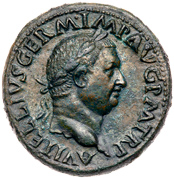 |
Vitellius. Æ Sestertius (29.08 g), AD 69. Rome. A VITELLIVS GERM IMP AVG P M TR P, laureate head of Vitellius right. Rev. PAX AVGVSTI, S C across field, Pax standing facing, head left, holding branch and cornucopaie. Cf. RIC 157 (obv. legend); BMC p. 377. An incredible coin. A masterpiece sestertius of Vitellius. Uniform chocolate brown patina. Worthy of a record price. Superb Extremely Fine. Estimate Value $9,000 - UP
Ex NCirc (May 1940, G34), 98782; G. Gillet Collection (Florange et Ciani, 28 May 1924); F. Gnecchi Collection; Lord Sidmouth Collection; C.E.G. Mackerell Collection (Sotheby's, 18 May 1906), 60; J. Tyszkiewicz Collection (Serrure, 25 June 1901).
Vitellius was made Governor of Lower Germany by Galba. When the legions became disaffected from Galba's austere and strict rule, they renounced their allegiance to him and hailed Vitellius as emperor. Vitellius at first refused the imperial title, but he did take the name Germanicus and pledged to lead the revolt. Shortly thereafter the provinces of Britain, Gaul and Spain defected to him. Meanwhile in Rome Galba had been murdered and Otho installed as the new emperor by the Praetorian Guard. Otho offered to share the emperorship with Vitellius, but the latter, whose forces were already marching on Rome, refused. A decisive engagement, the Battle of Bedriacum, was fought between the two sides in the vicinity between Cremona and Verona, and Vitellius's forces were victorious. Despite losing at Bedriacum, Otho perhaps could still have won the war - he had the support of the formidable legions of Dalmatia, Moesia and Pannonia, as well as both the Praetorian Guard and the Roman fleet - but instead chose to avoid civil war by committing suicide. Once in Rome the Senate decreed Vitellius the usual imperial honors. The historians Suetonius, Tacitus and Dio Cassius do not record much positive about Vitellius's short reign, but he did implement some worthwhile and lasting changes (for instance, he accepted equites into the offices of imperial administration whereas before they had been open only to freedmen). Overall, though, his reign was irresolute, and Vitellius himself is described as lazy and self-indulgent.
View details and enlarged photos
| Realized
$24,000 |
Lot 261 |
 |
Vespasian. Gold Aureus (7.46 g, 6h), AD 69-79. Mint of Rome, A.D. 76. IMP CAESAR VESPASIANVS AVG, laureate head facing right. Rev. COS VII, heifer walking right (RIC 840; Calicó 622; BMC 176). Some lustre, Nearly Extremely Fine. Estimate Value $18,000 - UP
Ex Numismatica Ars Classica, Auction 52, 7 October 2009, lot 1023 Ex Spink, Auction 13015, 2 December 2013, lot 156.
View details and enlarged photos
| Unsold |
Lot 262 |
 |
Vespasian. Gold Aureus (6.37 g), AD 69-79. Judaea Capta type. Rome, AD 70. IMP CAESAR VESPASIANVS AVG, laureate head of Vespasian right. Rev. COS ITER TR POT, Pax seated left, holding branch and caduceus. RIC 28; BN 17; BMC 28; Calicò 607. Very Fine. Estimate Value $4,000 - UP
From the S. Moussaieff Collection, This lot has been officially exported from Israel through the Israel Antiquities Authority.
View details and enlarged photos
| Unsold |
Lot 263 |
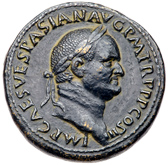 |
Vespasian. Æ Sestertius (26.38 g), AD 69-79. 'Judaea Capta' type. Rome, AD 71. IMP CAES VESPASIAN AVG P M TR P P P COS III, laureate head of Vespasian right. Reverse: IVDAEA CAPTA, S C in exergue, palm tree; to left, emperor standing right, foot on helmet, holding spear and parazonium; to right, Jewess�in attitude of mourning seated right on cuirass. Hendin 1504; RIC 167; BN 497-8; BMC 543. Smoothed and with tooling, dark patination. About Extremely Fine. Estimate Value $10,000 - UP
View details and enlarged photos
| Unsold |
Lot 264 |
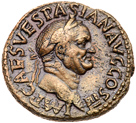 |
Vespasian. Æ dupondius (10.74 g), AD 69-79. Rome, AD 71. IMP CAES VESPASIAN AVG COS III, laureate head of Vespasian right. Rev. VICTORIA NAVALIS, S C low across field, Victory standing right on prow, holding wreath and palm. Hendin -; RIC 285; BN 574; BMC 598-9. Tan-brown patina. Choice Very Fine. Estimate Value $250 - UP
From the Palm Desert Collection. Ex Superior (7 June 1984), 1626.
View details and enlarged photos
| Realized
$528 |
Lot 265 |
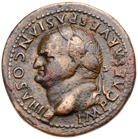 |
Vespasian. Æ As (10.74 g), AD 69-79. Rome, AD 77/8. IMP CAESAR VESPASIAN COS VIII, laureate head of Vespasian left. Rev. VICTORIA AVGVST, S C across field, Victory standing right on prow, holding wreath and palm. RIC 1014; BMC 740. Reddish-brown patina. Very Fine. Estimate Value $200 - UP
From the Palm Desert Collection.
View details and enlarged photos
| Realized
$630 |
Lot 266 |
 |
Titus. Gold Aureus (7.15 g, 12h), AD 79-81. Mint of Rome, as Caesar under Vespasian, A.D. 73. T CAES IMP VESP CENS, laureate head facing right. Rev. PONTIF TRI POT, Titus seated right on a curule chair, holding a sceptre and a branch, his feet resting on a stool (RIC 555; Calicó 753; BMC 114). Broad flan, excellent portrait, lustrous, Extremely Fine. Estimate Value $20,000 - UP
Ex Classical Numismatic Group, Triton XVII, 7 January 2014, lot 670.
View details and enlarged photos
| Unsold |
Lot 267 |
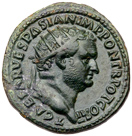 |
Titus. Æ Dupondius (12.51 g), as Caesar, AD 69-79. Rome, under Vespasian, AD 72. T CAESAR VESPASIAN IMP PONT TR POT COS II, radiate head of Titus right. Rev. FELICITAS PVBLICA, S C across field, Felicitas standing facing, head left, holding caducesu and cornucopiae. RIC 465; BN 628; cf. BMC 369 (obv. legend). Glossy dark green patina. Extremely Fine. Estimate Value $500 - UP
Ex NAC 98 (12 December 2016), 1117; Rauch 81 (23 November 2007), 335.
View details and enlarged photos
| Realized
$750 |
Lot 268 |
 |
Domitian. Gold Aureus (7.56 g, 6h), AD 81-96. Mint of Rome, A.D. 92-4. DOMITIANVS AVGVSTVS, laureate head facing right. Rev. GERMANICVS COS XVI, Minerva standing right on capital of a rostral column, holding a spear and a shield, an owl stands at her feet on right (RIC 744; Calicó 849; BMC 208). An exceptional portrait of Domitian, a few very light marks, otherwise well-struck in high relief on a broad flan. very rare. Superb Extremely Fine. Estimate Value $35,000 - UP
Ex Aurora Collection, The New York Sale XXXII, 8 January 2014, lot 13.
View details and enlarged photos
| Unsold |
Lot 269 |
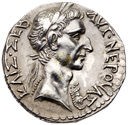 |
Nerva. Silver Tetradrachm (15.45 g), AD 96-98. Antioch in Syria, AD 96. AV NEPOVAΣ KAIΣ ΣEB, laureate bust of Nerva right, wearing aegis. Rev. ETOVΣ NEOV IEPOV, eagle standing facing, head right, on thunderbolt; in right field, TA monogram above palm branch. Prieur 149; McAlee 419. Boldly struck in high relief on excellent quality metal. The portrait of Nerva is absolutely amazing! A spectacular coin that should stir plenty of excitement. Superb Extremely Fine. Estimate Value $2,000 - UP
View details and enlarged photos
| Realized
$4,200 |
Lot 270 |
 |
Trajan. Gold Aureus (7.27 g, 7h), AD 98-117. Mint of Rome, A.D. 116. IMP CAES NER TRAIAN OPTIM AVG GER DAC PARTHICO, laureate, draped and cuirassed bust facing right. Rev. REGNA AD SIGNATA, Trajan seated left on a platform, with two attendants standing beside him; three kings (of Armenia, Parthia and Mesopotamia) stand to right before the platform (RIC 367; Calicó 1079; BMC 613). A very rare and historically interesting reverse type, About Extremely Fine. Estimate Value $20,000 - UP
View details and enlarged photos
| Unsold |
Lot 271 |
 |
Hadrian. Gold Aureus (6.95 g, 5h), AD 117-138. Mint of Rome, A.D. 125-8. HADRIANVS AVGVSTVS, laureate bust facing right, drapery on left shoulder. Rev. COS III, Hadrian galloping on horseback right, holding a spear (RIC 187d; Calicó 1224a; BMC 437). Attractive toning, good very fine. Estimate Value $18,000 - UP
Ex Feuardent Ex Aurora Collection, The New York Sale XXXII, 8 January 2014, lot 19.
View details and enlarged photos
| Unsold |
Lot 272 |
 |
Hadrian. Gold Aureus (7.41 g, 6h), AD 117-138. Mint of Rome, A.D. 125-8. HADRIANVS AVGVSTVS, laureate bust facing right, light drapery on left shoulder. Rev. COS III, Hadrian on horseback galloping right, holding a spear (RIC 187; Calicó 1228; BMC 435). An exceptional example, with an impressive bust of Hadrian struck on a broad flan, residual lustre beneath toning and Superb Extremely Fine, a superb coin. Estimate Value $40,000 - UP
Ex Collection of the Money Museum, Zurich Ex Triton XVIII, 6 January 2015, lot 1088 Ex Leu 72, 12 May 1998, lot 433.
View details and enlarged photos
| Unsold |
Lot 273 |
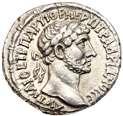 |
Hadrian. Silver Tridrachm (10.50 g), AD 117-138. Tarsus in Cilicia. Laureate head of Hadrian right. Rev. Tyche seated left, holding palm branch; at her feet to left, half-length figure of the river-god Cyndus swimming left. RPC 3259; Prieur 759; SNG BN 1405-6. A nice full strike on a full flan of excellent metal. Lightly toned. Superb Extremely Fine. Estimate Value $1,000 - UP
View details and enlarged photos
| Realized
$1,560 |
Lot 274 |
 |
Hadrian. Silver Tridrachm (9.10 g), AD 117-138. Tarsus in Cilicia. Laureate and cuirassed bust of Hadrian right, gorgoneion on breastplate. Rev. Lion attacking bull left. RPC 3265; Prieur 766; SNG BN 1398. Well struck on an excellent quality flan. Lightly toned. Choice Very Fine. Estimate Value $700 - UP
View details and enlarged photos
| Unsold |
Lot 275 |
 |
Aelius. Gold Aureus (7.14 g), Caesar, AD 136-138. Rome, under Hadrian, AD 137. L AELIVS CAESAR, bare head of Aelius left. Rev. TRIB POT COS II, PIE-TAS across field, Pietas standing rightsacrificing over alter at her feet to right, and holding box of perfumes. RIC 444c; BMC 1004; Calicó 1449. Ablaze with mint luster. Boldly stuck in high relief and perfectly centered. A numismatic materpiece! Superb Mint State. Estimate Value $50,000 - UP
Accompanied by an NGC Photo Certificate - Choice MS, Strike: 5/5, Surface: 5/5 Fine Style.
On 13 January AD 101, Lucius Ceionius Commodus was born to a Roman consular family from Etruria. Although he is known to have served as praetor in AD 130 and was married to the influential Avidia Plautia, his importance increased dramatically in AD 136, when the emperor Hadrian unexpectedly adopted him and thereby made him Caesar and heir to the purple. At the time of his adoption, Lucius Ceionius Commodus set aside his name and assumed the new name of Lucius Aelius Caesar that linked him to the gens Aelia to which Hadrian belonged. Up until this point it was widely believed that Gnaeus Pedanius Fuscus Salinator II, the grandson of the emperor's well-regarded brother-in-law, Lucius Julius Ursus Servianus, would be Hadrian's heir. Indeed, Hadrian had virtually indicated this himself by giving Salinator a privileged position in his court. However, all of the hopes and expectations for Salinator were dashed in AD 136 when Hadrian fell seriously ill and almost died from a haemorrhage. This near death experience caused the emperor to change his mind and adopt Aelius as his heir instead. This new decision, which the Historia Augustae describes as "against the wishes of everyone" sent political shockwaves through Rome and enraged both Servianus and Salinator. They were subsequently implicated in a (fabricated?) coup attempt and executed. Thus, Aelius was raised to power on a tide of unpopularity and bloodshed. It was not an auspicious beginning.As Caesar, Aelius' first order of business in AD 137 was to join the legions in Pannonia and defend the Danube frontier against Germanic incursions although he had no military experience of any kind. His Danubian campaigns seem to have met with success and he returned to Rome to make a public address at the start of the New Year, AD 138. Although his speech was said to have been well composed and a model for future rhetoricians, Aelius never presented it. He fell ill shortly before and died after drinking a potion intended to help him. It has been suggested that Aelius may have been killed by the onset of tuberculosis. Hadrian honored his dead heir with monumental statues and temples. The emperor then chose Antoninus Pius to be his new heir and Caesar, but ordered Pius to adopt Lucius Verus, the son of Aelius, with the intention that he would become Caesar to Antoninus Pius after he assumed power as Augustus.The present aureus features a spectacular portrait of Lucius Aelius in high relief. He is shown bare headed in order to indicate his junior status as Caesar. In the early second century only senior emperors, Augusti, were depicted wearing laurel wreaths. The virtually flawless state of preservation makes this a superlative image of the short-lived Caesar. Pietas is shown sacrificing over an altar on the reverse, symbolizing that Aelius was dutiful in his relationship with Hadrian, the Roman people, and the gods. Such a representation was appropriate to the New Year's vows made by emperors and may suggest that this aureus was struck for distribution as largesse at the beginning of January, AD 137, when Aelius assumed his second consulship (noted in the reverse legend) before setting off for his post in Pannonia. A ruler who could justly claim pietas was likely to be successful, since he zealously undertook his duties to both gods and men. Who therefore would stand in his way? Unfortunately, while pietas justified a Roman ruler in the human and divine spheres it did nothing to placate bacteria. Pietas could not, and did not save Aelius from the disease that killed him a year after this aureus was struck.
View details and enlarged photos
| Realized
$120,000 |
Lot 276 |
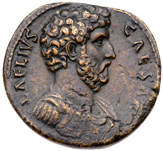 |
Aelius. Æ Sestertius (23.48 g), Caesar, AD 136-138. Rome, AD 137. L AELIVS CAESAR, bare-headed, draped and cuirassed bust of Aelius right. Rev. TR PO[T CO]S II, S C across field, Spes advancing left, holding flower and raising hem of skirt. RIC 1055. Excellent portrait quality, rendered in bold high relief. Much rarer cuirassed portrait type. Natural flan crack, some light surface smoothing with uniform reddish-brown patina. Choice Very Fine. Estimate Value $1,500 - UP
Ex Ebert Collection (Stack's-Bowers, 12 January 2013), 5366.
View details and enlarged photos
| Unsold |
Lot 277 |
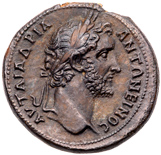 |
Antoninus Pius. Æ 33. (21.05 g), AD 138-161. Philippopolis in Thrace. Gargilius Anticus, hegemon. Laureate head of Antoninus Pius right. Rev. The river-god Hebros reclining left, holding branch and resting against overturned amphora from which water flows. Varbanov 692; RPC III �. Wonderful high-relief, great style. Reddish-brown patina. Extremely Fine. Estimate Value $2,000 - UP
The city of Philippopolis (modern Plovdiv in Bulgaria) was founded as a colony by Philip II of Macedon in 342 BC in order to maintain a Macedonian presence in the heart of Thracian territory. It was built on the crests of three hills from which it ultimately derived its Latin nickname, Trimontium ("Three Hills"). As part of the ongoing Third Mithridatic War (74-63 BC), in 72 BC, the city was captured by M. Terentius Varro Lucullus, the Roman governor of Macedonia. In AD 46, Philippopolis was incorporated into a new Roman province of Thrace and flourished as a provincial trade center. The city was beautified by an extensive public building program, particularly under the Flavian emperors, and continued to grow in size and importance. In the third century AD, Philippopolis boasted a population of more than 100,000 people and became the provincial capital.This wonderfully preserved bronze issue was struck under Antoninus Pius while the city was still on its journey towards preeminent status within the province. The obverse features an attractive portrait of the emperor while the reverse depicts the local river god Hebros reclining on an overturned amphora from which water pours. This type may possibly represent a fountain statue of the god incorporated into the city's nymphaeum. The surrounding Greek legend names both the Philippopolitans and the city magistrate (hegemon) Gargilius Anticus as the authorities behind the issue. One of the duties of Philippopolitan hegemones may have been to underwrite the cost of civic coin production. Such duties (known as liturgies) were commonplace for wealthy office-holders in Greek cities of the Hellenistic and Roman ages. Through liturgies the cities were able to maintain necessary services and keep up their appearances while the liturgist was memorialized for his benevolence. The system worked better than anyone could have predicted. It seems improbable that when Gargilius Anticus funded this coinage with his name on it he realized that he was actually buying a guarantee that his name would still be written and spoken almost 2000 years later. Whatever he may have paid, Anticus got a bargain.
View details and enlarged photos
| Unsold |
Lot 278 |
 |
Marcus Aurelius, AD 161-180. AE 36 mm (23.34 g). Minted in Pergamon AD 169-175. Strategos Titos Klaudios Aristeas. Draped and lauareate bust right. Rev. Zeus seated left holding sceptre on high back chair holding Nike in r. hand. BMC 288; SNG France ___. Some smoothing in the fields noted. A marvelous example featuring glossy dark chocolate brown patina. Extremely Fine/ Choice Very Fine. Estimate Value $5,000 - UP
A similar example appeared in Giessener Münzhandlung 133, München 2004, #320.
View details and enlarged photos
| Unsold |
Lot 279 |
 |
Lucius Verus. Gold Aureus (7.30 g, 12h), AD 161-169. Mint of Rome, A.D. 163-4. L VERVS AVG ARMENIACVS, bare head facing right. Rev. TR P III-I IMP II COS II / REX ARMEN / DAT, Lucius Verus seated left on a platform; an officer standing beside him; a soldier stands before him; King Sohaemus stands to left before them at the foot of the platform (RIC 512; Calicó 2154 (these dies); BMC 300; Kent-Hirmer, pl. 98, 342 (these dies)). Perfectly struck in high relief, with a wonderful portrait, lustrous and mint state, a superb example of this historical issue. Estimate Value $50,000 - UP
Ex Numismatica Ars Classica, Auction 38, 21 March 2007, lot 82 Ex Aurora Collection, The New York Sale XXXII, 8 January 2014, lot 28.
View details and enlarged photos
| Unsold |
Lot 280 |
 |
Lucius Verus. Gold Aureus (7.32 g), AD 161-169. Rome, AD 163/4. L VERVS AVG ARMENIACVS, laureate, draped and cuirassed bust of Lucius Verus right. Reverse: TR P IIII IMP II COS II, Victory standing facing, head right, supporting shield inscribed VIC/AVG in two lines on palm tree. RIC 525; Szaivert 94-12/37; BMC 296, note; Calicó 2177 (same dies as illus.). Needle sharp! Boldly struck in high relief and perfectly centered. A splendid gem example. Perfection! NGC grade Gem MS; Strike: 5/5, Surface: 5/5. Fine style. Estimate Value $20,000 - UP
View details and enlarged photos
| Realized
$24,000 |
Lot 281 |
 |
Septimius Severus. Æ As (11.92 g), AD 193-211. SEVERVS PIVS AVG BRIT, laureate head of Septimius Severus right. Reverse: VICTORIAE BRITTANNICAE, S C in exergue, Victory standing right, holding trophy with both hands; at her feet to either side, bound seated captive. RIC 837a. Very rare reverse type. Dark green patina with some reddish spots, details lightly strengthened. Choice Very Fine. Estimate Value $750 - UP
View details and enlarged photos
| Unsold |
Lot 282 |
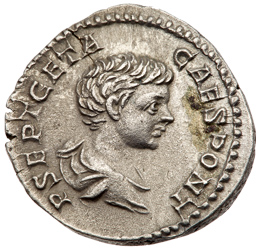 |
Julia Domna, with Geta, as Caesar. Silver Denarius (2.91 g), Augusta, AD 193-217. Rome, under Septimius Severus and Caracalla, AD 201/2. IVLIA AVGSTA, draped bust of Julia Domna right. Reverse: P SEPT GETA CAES PONT, bare-headed, draped and cuirassed bust of Geta right. RIC 571; BMC 60; RSC 1. Rare. Light grey tone. Extremely Fine. Estimate Value $700 - UP
The dynastic types of the Severan dynasty have long been favorites amongst collectors of Roman Imperial coinage. They come in various permutations, different metals, and from different Imperial mints. The purpose was to legitimate the Severan dynasty after the tumultuous reign of Commodus and the subsequent years of civil war, and to sustain the idea of dynastic rule that had been reestablished by Marcus Aurelius, whom Severus claimed was his father. It appears that all of the Severan dynastic issues were struck at the same time, in AD 201/2, at the time that Severus and Caracalla assumed the joint consulate for AD 202.
View details and enlarged photos
| Unsold |
Lot 283 |
 |
Caracalla. Gold Aureus (7.39 g, 12h), AD 198-217. Mint of Rome, A.D. 196-8. M AVR ANTON CAES PONTIF, bare-headed, draped and cuirassed bust facing right. Rev. PRI-NCI-PI IVVE-NTVTIS, Caracalla standing left, holding a baton and a spear, beside a trophy of arms (RIC 13b; Calicó 2797; C 504). Rare. Extremely Fine. Estimate Value $35,000 - UP
Ex Leu 53, 1991, lot 285 Ex Kunker 273, 2016, lot 836.
View details and enlarged photos
| Unsold |
Lot 284 |
 |
Caracalla, with Septimius Severus and Julia Domna. Gold Aureus (7.36 g, 6h), AD 198-217. Mint of Rome, A.D. 202. ANTON P AVG PON TR P V COS, laureate, draped and cuirassed bust facing right. Rev. CONCORDIAE AETERNAE, conjoined busts of Septimius Severus, radiate and draped, and Julia Domna, diademed and draped, on a crescent, facing right (RIC 59a; Calicó 2850; C 2). A few light marks on edge, three excellent portraits. Very Rare. About Extremely Fine. Estimate Value $70,000 - UP
Ex Kunker 273, 14 March 2016, lot 845.
View details and enlarged photos
| Unsold |
Lot 285 |
 |
Maximinus I 'Thrax'. Æ Sestertius (21.72 g), AD 235-238. Rome, AD 236/7. MAXIMINVS PIVS AVG GERM, laureate, draped and cuirassed bust of Maximinus I right. Rev. VICTORIA GERMANICA, S C across field, emperor standing facing, head left, holding scepter, being crowned by Victory standing behind, holding palm branch; to left, bound German captive seated left. RIC 90; BMC 191. Glossy chocolate brown with hints of red patina. Boldly struck and absolutely superb in detail. Superb Extremely Fine or better. Estimate Value $1,500 - UP
Ex Baldwin's inventory, March 1937; L. Vierordt Collection, pt. 1 (Schulman 139, 5 March 1923), 2098.
This handsome sestertius utilizes an realistic portrait of Maximinus, which shows his large chin and and other heavy facial features. According to the ancient author and contemporary, Herodian, Maximinus was "of such frightening appearance and colossal size that there is no obvious comparison to be drawn with any of the best-trained Greek athletes or warrior elite of the barbarians" (Herodian vii.1.2). This has lead some modern researchers to suspect that Maximinus suffered from some form of growth disorder, such as gigantism or acromegaly.
View details and enlarged photos
| Unsold |
Lot 286 |
 |
Gordian I. Silver Denarius (2.94 g, 6h), AD 238. Mint of Rome. IMP M ANT GORDIANVS AFR AVG, laureate and draped bust facing right. Rev. P M TR P COS P P, Gordian standing left, holding a branch in his extended right hand, and a short sceptre in left (RIC 1; C 2). Lightly toned, About Extremely Fine. Estimate Value $8,000 - UP
Ex Imagines Imperatorvm, Aureo & Calicó, 8 February 2012, lot 204.
View details and enlarged photos
| Unsold |
Lot 287 |
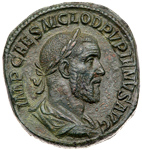 |
Pupienus. Æ Sestertius (23.13 g), AD 238. Rome. IMP CAES M CLOD PVPIENVS AVG, laureate, draped and cuirassed bust of Pupienus right. Rev. P M TR P COS II P P, S C across field, emperor, togate, standing facing, head left, holding branch and parazonium. RIC 16; BMC 28. A marvelous Pupienus sestertius. Bold strike with full legends and glossy greenish-brown patina. Extremely Fine. Estimate Value $2,000 - UP
Ex SCMB M228 (July 1934), no. 17530, where there were offered two sestertii of Pupienius, held together from antiquity, this being the finer.
When Gordian I and his son were proclaimed emperors in Africa, the Senate appointed a committee of twenty men, including the elderly Senator Pupienus, to co-ordinate operations against Maximinus until the arrival of the Gordians. On the news of the defeat and deaths of the Gordiani at Carthage, however, the Senate met in closed session in the Temple of Jupiter Capitolinus and voted for two members of the committee to be installed as co-emperors - Balbinus and Pupienus. Coins from both these emperors' very short reign are rare.
View details and enlarged photos
| Unsold |
Lot 288 |
 |
Gordian III. Gold Aureus (4.85 g), AD 238-244. Rome, AD 239. IMP CAES M ANT GORDIANVS AVG, laureate, draped and cuirassed bust of Gordian III right. Rev. P M TR P II COS P P, Jupiter standing facing, head left, holding thunderbolt and scepter; at his feet to left, small figure of the emperor, togate, standing left, holding patera. RIC 21; Calicó 3211. Fully lustrous. NGC photo grade Ch AU; Strike: 4/5, Surface: 3/5. Flan flaw. Estimate Value $3,000 - UP
View details and enlarged photos
| Realized
$3,300 |
Lot 289 |
 |
Trajan Decius. Æ Double Sestertius (44.62 g), AD 249-251. Rome, AD 250. IMP C M Q TRAIANVS DECIVS AVG, radiate and cuirassed bust of Trajan Decius right. Rev. VICT-ORIA AVG, S C across field, Victory advancing left holding wreath and palm. RIC 126a; Banti 29 = RCTV 9397 (this coin illus.); Gnecchi III 6, pl. 161, 4. Uniform green patina. Boldly struck, perfectly centered, and a full size flan. Most impressive. Extremely Fine. Estimate Value $3,000 - UP
Ex Sternberg XXVIII (30 October 1995), 264; NFA XXIX (13 August 1992), 416; Sir Arthur J. Evans Collection (Ars Classica XVII, 3 October 1934), 1685; Sir John Evans Collection.
View details and enlarged photos
| Realized
$7,200 |
Lot 290 |
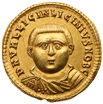 |
Licinius II (Caesar). Gold Aureus (5.33 g, 12h), AD. 317-324. Mint of Nicomedia, A.D. 321-2. D N VAL LICIN LICINIVS NOB C, bust facing, draped and cuirassed. Rev. IOVI CONSER-VATORI CAES, Jupiter seated facing on a platform inscribed SIC �V� / SIC �X�, holding Victory and a sceptre, an eagle stands at his feet on left, with a wreath in its beak, SMNG in exergue (RIC 42; Calicó 5151 (this reverse die); Depeyrot 31/2). With a superb fully facing portrait of excellent style, broad flan, toned. Very rare. About Extremely Fine. Estimate Value $35,000 - UP
Ex Numismatica Ars Classica, Auction 54, 24 March 2010, lot 612 Ex Aurora Collection, The New York Sale XXXII, 8 January 2014, lot 56.
View details and enlarged photos
| Unsold |
Lot 291 |
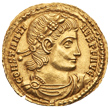 |
Constantius II, AD 337-36. Gold Solidus (4.39g). Minted at Siscia. Issued for the Donativum, the celebration on taking of office in AD 337. CONSTANTI NVS PF AVG, Draped and cuirassed bust of Constantinus II r. with rosette and laurel diadem. Rev. VICTORIA CONSTANTINI AVG, Victory wearing long dress advancing r., kicking with her l. foot seated captive; she holds wreath inscribed VOT XXX with both hands. RIC VIII, 349-4; Depeyrot II, 199, 3/2; Bastien, Donativum 82, a/note 5. Very rare issue and excellent style. Slightly double struck on the dotted border. Extremely Fine. Estimate Value $17,000 - UP
Ex Auction ROMA Numismatics Ltd., London IX (2015), 832.
View details and enlarged photos
| Unsold |
Lot 292 |
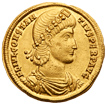 |
Constantius II. Gold Solidus (4.40 g, 6h), AD 337-361. Mint of Antioch, A.D. 347-55. FL IVL CONSTAN-TIVS P F AVG, pearl and rosette-diademed, draped and cuirassed bust facing right. Rev. GLORIA REI PVBLICAE, Roma, holding a spear, and Constantinopolis, holding a sceptre and resting her right foot on a prow, enthroned, supporting between them a wreath inscribed VOT / XX / MVLT / XXX, SMANG in exergue (RIC 84; C 108; Depeyrot 6/3). Some lustre, rare and Extremely Fine. Estimate Value $4,000 - UP
View details and enlarged photos
| Unsold |
Lot 293 |
 |
Constantius II. Gold Solidus (4.51 g, 12h), AD 337-361. Mint of Nicomedia, A.D. 355-361. D N CONSTAN-TIVS P F AVG, pearl-diademed head facing right. Rev. GLORIA REI PVBLICAE, Roma, holding a spear, and Constantinopolis, holding a sceptre and resting her right foot on a prow, enthroned, supporting between them a wreath inscribed VOT / XXXX, SMNS in exergue (RIC 100; Depeyrot 6/1). Well-struck in high relief, very rare and Extremely Fine. Estimate Value $7,000 - UP
Ex Hess-Divo 307, 7 June 2007, lot 1767 Ex Triton XVII, 7 January 2014, lot 801.
View details and enlarged photos
| Unsold |
Lot 294 |
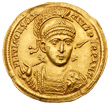 |
Constantius II. Gold Solidus (4.52 g, 12h), AD 337-361. Mint of Nicomedia, A.D. 351-5. FL IVL CONSTAN-TIVS PERP AVG, pearl-diademed, helmeted and cuirassed bust facing, slightly inclined to the right, holding a spear and shield. Rev. GLORIA REI PVBLICAE, Roma, holding a spear, and Constantinopolis, holding a sceptre and resting her right foot on a prow, enthroned, supporting between them a wreath inscribed VOT / XXX / MVLT / XXXX, SMNG in exergue (RIC 74; Depeyrot 5/2). One tiny mark on cheek, lightly toned, Extremely Fine. Estimate Value $6,000 - UP
View details and enlarged photos
| Unsold |
Lot 295 |
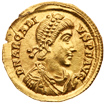 |
Arcadius. Gold Solidus (4.47 g, 6h), AD 383-408. Mint of Mediolanum, A.D. 394-5. D N ARCADI-VS P F AVG, pearl-diademed, draped and cuirassed bust facing right. Rev. VICTORI-A AVGGG, Emperor standing right, holding a labarum and Victory on a globe, his left foot resting on a bound captive, M-D in field, COMOB in exergue (RIC 35b; Depeyrot 16/1). Lustrous, a beautiful example. Superb Extremely Fine. Estimate Value $4,000 - UP
Ex Aurora Collection, The New York Sale XXXII, 8 January 2014, lot 63.
View details and enlarged photos
| Unsold |
|
|